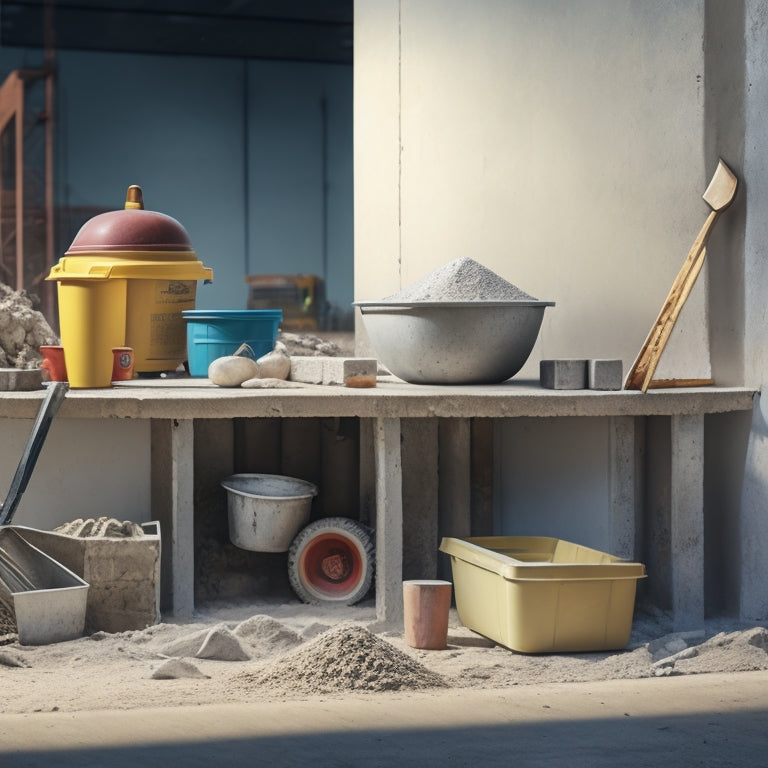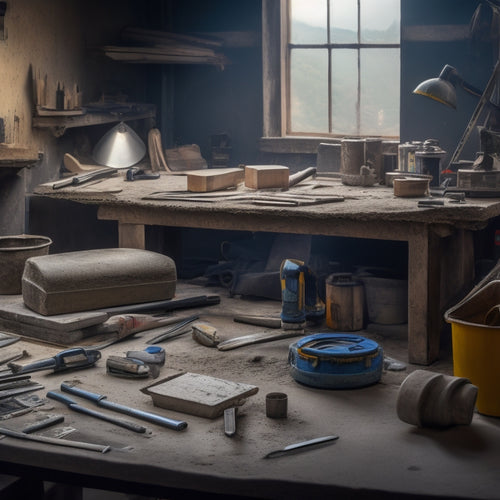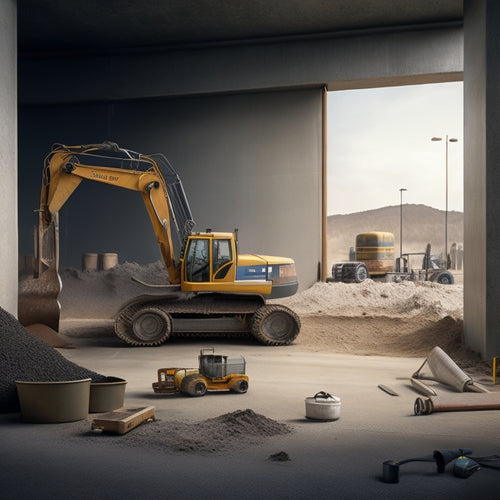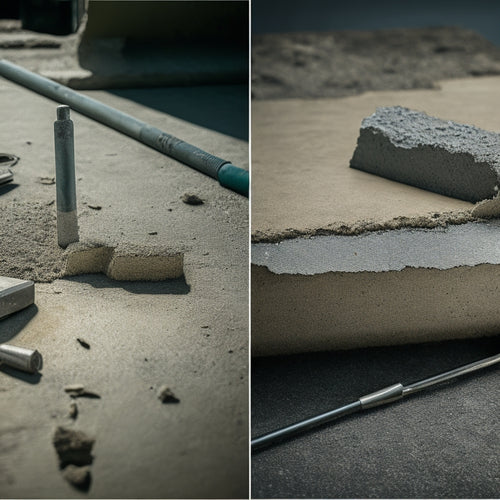
5 Key Tools for Mixing and Pouring Concrete Blocks
Share
When you're mixing and pouring concrete blocks, you need a solid lineup of tools to get the job done right. You'll require a sturdy mixing bucket or drum, a mixing trowel or shovel, and a mechanical mixer to guarantee thorough blending. A pouring bucket or hopper, screed board or strike-off tool, and tamping tool or vibratory plate are also must-haves for efficient and accurate pouring. Additionally, digital scales, measuring cups, and calibrated cylinders are vital for precise measurements. By having these essential tools on hand, you'll be able to achieve a strong, uniform final product - and with further knowledge, you can optimize your process for even better results.
Key Takeaways
• A sturdy mixing bucket or drum is essential for durability and repeated use in mixing concrete blocks.
• A mechanical mixer, such as drill-powered or stand-alone, ensures thorough blending of materials.
• A pouring bucket or hopper is necessary for transporting mixed concrete efficiently to the pouring site.
• A screed board or strike-off tool is vital for leveling and smoothing poured concrete to achieve uniform block quality.
• A tamping tool or vibratory plate is needed to remove air pockets and compact concrete for a dense finish.
Essential Mixing Equipment Needed
When preparing to mix concrete blocks, you'll need a set of essential mixing equipment to guarantee a consistent and high-quality product. A sturdy mixing bucket or drum is a must-have, as it will withstand the rigors of repeated mixing and cleaning.
A mixing trowel or shovel is also important, allowing you to efficiently combine cement, aggregate, and water. To achieve the best mixing results, invest in a mechanical mixer, such as a drill-powered mixer or a stand-alone concrete mixer. This equipment will assure thorough blending and a uniform consistency.
Regular equipment maintenance is essential to extend the lifespan of your mixing equipment and prevent contamination. Clean your mixing tools and bucket after each use, and store them in a dry area. Additionally, perform routine checks on your mechanical mixer to confirm it's functioning correctly.
Crucial Pouring Accessories Required
What equipment do you need to secure a smooth, accurate pouring process for your concrete blocks?
To achieve this, you'll require some essential pouring accessories.
First, a pouring bucket or hopper is necessary for containing and transporting the mixed concrete to the block molds. This guarantees a mess-free and efficient pouring process.
Next, a screed board or strike-off tool is vital for leveling and smoothing out the poured concrete. This helps achieve a uniform surface and guarantees accurate block alignment.
Additionally, a tamping tool or vibratory plate is required to remove any air pockets and compact the concrete, resulting in a dense and strong block.
Finally, a spirit level and string lines are necessary for maintaining precise block alignment and guaranteeing that the blocks are poured perfectly level.
Measuring Tools for Accurate Mix
To guarantee the concrete blocks meet specifications and possess the required strength, you must accurately measure the mix components, which requires a set of precise measuring tools. Inaccurate measurements can lead to inconsistent mixing ratios, compromising the block's structural integrity.
To achieve ideal mixing ratios, you'll need:
-
Digital scales: for precise weight measurements of cement, aggregate, and water
-
Measuring cups and scoops: for accurate volume measurements of dry and liquid components
-
Calibrated cylinders: for measuring the exact amount of water and admixtures
-
Moisture meters: to determine the ideal water content for the mix
-
Thermometers: to monitor the temperature of the mix, essential for achieving the desired strength and durability
With these measuring tools, you can guarantee measuring accuracy, which is critical for producing high-quality concrete blocks that meet industry standards.
Safety Gear for Protection
You must don the right safety gear to protect yourself from the physical hazards and health risks associated with mixing and pouring concrete blocks.
The first line of defense is protective gloves, which shield your hands from abrasive materials, harsh chemicals, and rough block surfaces. Opt for heavy-duty, puncture-resistant gloves that provide grip and dexterity.
Next, guarantee you have proper eye protection. Safety goggles or glasses with shatter-resistant lenses will safeguard your eyes from flying debris, chemical splashes, and other hazards. A face shield can provide additional protection for your face and neck.
Don't forget to wear a dust mask or respirator to prevent inhaling concrete dust and other airborne particles. This is particularly vital when mixing and pouring concrete, as the dust can cause respiratory issues.
Finally, wear sturdy, closed-toe shoes and long pants to protect your feet and legs from heavy blocks and other hazards.
Finishing Tools for Block Shaping
With your safety gear in place, you're ready to focus on shaping your concrete blocks into precise forms, which requires a set of specialized finishing tools.
These tools will help you achieve the desired shape and surface finish for your blocks. Mastering block shaping techniques and surface finishing methods is vital for producing high-quality blocks that meet industry standards.
Here are some essential finishing tools you'll need:
-
Tamping tools: Used to compact and smooth out the concrete surface, ensuring a dense and even finish.
-
Floats: Long, flat tools used to smooth and level the concrete surface, removing any imperfections.
-
Edgers: Used to create clean, sharp edges and corners on your blocks.
-
Jointing tools: Designed to create precise joints and seams between blocks.
-
Grinding tools: Used to remove excess material, smooth out rough spots, and achieve a high-gloss finish.
Frequently Asked Questions
Can I Mix and Pour Concrete Blocks in Extreme Weather Conditions?
When you're planning to mix and pour concrete blocks, you must consider the weather conditions.
Extreme temperatures can greatly impact the concrete's quality and strength. In hot weather, you'll need to take precautions to prevent rapid drying, such as using cooling systems or shading.
In cold weather, you'll need to make sure the temperature is above 40°F (4°C) to allow proper curing.
You should also be prepared for wind and precipitation, which can affect the mixing and pouring process.
Take necessary weather precautions to guarantee a successful outcome.
How Do I Prevent Concrete Blocks From Sticking to Molds?
When you're pouring concrete blocks, preventing them from sticking to molds is essential.
You'll want to verify proper surface preparation by cleaning and drying the mold thoroughly.
Apply a mold release agent, such as a silicone-based spray or oil, to the mold's surface. This will create a barrier between the concrete and mold, allowing for easy removal once set.
Make certain to follow the manufacturer's instructions for the release agent to assure successful block extraction.
Can I Reuse Concrete Molds After Initial Use?
You're wondering if you can reuse concrete molds after initial use. The answer is yes, but it's essential to prioritize mold maintenance and cleaning.
Properly cleaning your molds with a wire brush and mild detergent guarantees the removal of residual concrete and prevents damage.
Dry the molds thoroughly to prevent rust or corrosion. By doing so, you'll extend the lifespan of your molds and make certain they remain in good condition for future use.
How Do I Determine the Ideal Concrete Block Size for a Project?
When determining the ideal concrete block size for your project, you'll need to take into account the project requirements and block dimensions.
You'll want to make sure the blocks fit snugly together, leaving minimal gaps.
Measure the area where the blocks will be placed, taking into account any obstructions or curves.
Calculate the number of blocks needed, factoring in their size and the pattern you'll use.
Balance aesthetics with functionality to achieve the perfect block size for your project.
What Is the Minimum Curing Time for Concrete Blocks?
You'll need to verify your concrete blocks undergo adequate curing to achieve ideal strength.
The minimum curing time typically ranges from 24 to 48 hours, depending on the curing methods used.
It's essential to maintain high moisture retention during this period to prevent premature drying.
You can achieve this through methods like misting, covering with plastic sheets, or applying curing compounds.
Proper curing will guarantee your concrete blocks reach their full potential.
Conclusion
You've got the right tools, now it's time to get mixing and pouring.
But don't think you can just wing it - having the right equipment is vital to producing high-quality concrete blocks.
You might be thinking, 'What's the big deal? I've mixed and poured concrete before.'
But the reality is, without the right tools, you're risking inconsistent quality, wasted materials, and even safety hazards.
Don't compromise on quality - invest in the essential tools and accessories to guarantee your concrete blocks meet professional standards.
Related Posts
-

3 Best Hand Tools for DIY Concrete Construction
When tackling a DIY concrete construction project, you'll need three essential hand tools to achieve a professional-l...
-

Why You Need Affordable Concrete Wall Construction Tools
You need affordable concrete wall construction tools to guarantee a profitable project, as the cost of equipment can ...
-

Top Tools for Concrete Adhesion Success
When it comes to concrete adhesion success, you'll need to wield the right tools and techniques to guarantee a strong...


